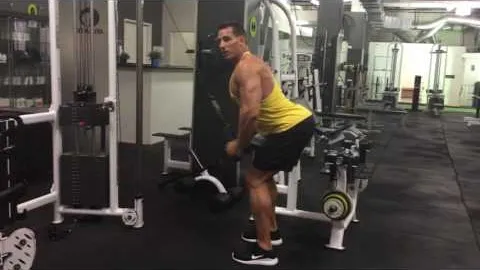

Are you looking to build a strong and well-defined upper body? Look no further than the standing cable rope pullover exercise! This compound movement targets the back, chest, and shoulder muscles, providing a complete upper body workout. In this guide, we will delve into the details of this exercise, including its benefits, proper form, variations, and tips for maximizing your results.
The standing cable rope pullover exercise offers a wide range of benefits for both beginners and advanced fitness enthusiasts. Some of the key advantages include:
Muscle Activation: The exercise primarily targets the latissimus dorsi (back muscles), pectoralis major (chest muscles), and deltoids (shoulder muscles). Additionally, it engages the trapezius muscles, lumbosacral region, and core muscles, resulting in overall upper body development.
Improved Posture: By strengthening the back muscles, the standing cable rope pullover exercise helps improve posture and spinal alignment, reducing the risk of postural imbalances and related injuries.
Enhanced Core Stability: The exercise requires core engagement to maintain stability and balance throughout the movement. Consistent practice can lead to improved core strength and stability.
Increased Range of Motion: The exercise involves a controlled stretching of the chest and shoulder muscles, helping to increase flexibility and range of motion in these areas.
Functional Fitness: The standing cable rope pullover exercise mimics real-life pulling and reaching movements, making it highly beneficial for functional fitness and everyday activities.
To perform the standing cable rope pullover exercise with correct form, follow these step-by-step instructions:
Set-up: Start by attaching a rope handle to the high pulley of a cable machine. Stand facing the machine with your feet shoulder-width apart and knees slightly bent.
Handle Grip: Grasp the rope handle with an overhand grip, ensuring that your hands are shoulder-width apart. Position your hands slightly higher than shoulder level.
Starting Position: Extend your arms forward while keeping a slight bend in your elbows. Your torso should be upright, and your feet firmly planted on the ground.
Execution: Initiate the movement by pulling the rope downward and backward in a semicircular motion, while simultaneously leaning slightly forward. Keep your arms extended throughout the movement.
Stretch and Contraction: Continue pulling until your hands reach your thighs, feeling a deep stretch in your chest and shoulder muscles. Pause for a brief moment, then reverse the motion to return to the starting position.
Breathing: Remember to exhale as you pull the rope and inhale as you release back to the starting position. Maintain controlled breathing throughout the exercise.
Repetitions and Sets: Aim to perform 10-12 repetitions for beginners and 12-15 repetitions for more advanced individuals. Complete 2-3 sets with a rest period of 30-60 seconds between sets.
To add variety to your workout routine or target specific muscle groups, you can try the following variations of the standing cable rope pullover exercise:
Single Arm Cable Rope Pullover: Perform the exercise with one arm at a time, focusing on unilateral strength and stability. Alternate between the left and right sides for optimal balance.
Seated Cable Rope Pullover: Instead of standing, sit on a bench or stability ball while performing the exercise. This variation places more emphasis on core stability.
Wide Grip Cable Rope Pullover: Position your hands wider apart on the rope handle to increase activation of the outer chest and back muscles.
Underhand Grip Cable Rope Pullover: Reverse your grip on the rope handle, using an underhand grip. This variation shifts the focus to the lower chest and lats.
Follow these tips to maximize the benefits and effectiveness of the standing cable rope pullover exercise:
Warm-Up: Prioritize a thorough warm-up routine and dynamic stretching to prepare your muscles and joints for the exercise.
Proper Weight Selection: Choose a weight that allows you to maintain proper form and complete the recommended number of repetitions. Gradually increase the weight as your strength improves.
Engage Your Core: Focus on maintaining a stable core throughout the exercise. Avoid excessive arching or rounding of the back.
Mind-Muscle Connection: Visualize the targeted muscles working during each repetition. This mental connection can help enhance muscle activation and overall results.
Full Range of Motion: Ensure that you perform the exercise through a full range of motion, allowing for a complete stretch and contraction of the muscles involved.
Controlled Tempo: Maintain a controlled tempo throughout the exercise, avoiding any jerky or sudden movements. This controlled approach will prioritize muscle engagement and reduce the risk of injury.
Incorporate the standing cable rope pullover exercise into your upper body workouts to develop a strong and well-defined physique. Remember to consult with a fitness professional if you have any specific concerns or limitations. Stay consistent, challenge yourself progressively, and enjoy the benefits of this powerful compound movement!
If you're looking for a gym, fitness club or yoga studio, you've come to the right place.
You can find information about gyms in your area. Browse catalog of gyms and find gyms with classes which are you looking for.
On gym page you can find simple information like address, phone or website. You can find list of available classes. You can check availability of personal training or small group classes. On place page you can also see information about open hours.
You can find gyms near you with amenities, courts, studios and equipments.
Use our map to find gym at your city or district.
In Gym Navigator you can find list of exercises with movies for many body parts.
You can browse exercises catalog and find exercises the best of you.
You can also find exercises grouped into workout plans, which you can use to improve you body. Each routine show you exercises one by one and give you possibility to count you progress and count down rest time.